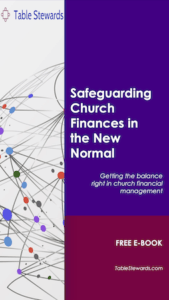Introduction
So, why should you seek ways to keep your church or charity from losing income?
Churches and charities largely rely on giving or donations to fund their core missions and therefore know how important it is to keep that income coming in.
When the income received is not protected or maximised, the ability to deliver good causes through missions, projects and services is hindered.
Also, when avenues to increase income are not explored, churches and charities lose out on income that can take them further in promoting good causes and benefitting humanity.
Threats are ever present where money exists, and churches and charities are not exempted.
Statistics show that organisations generally lose 5% of their income to fraud annually.
Fraud against Christian organisations is growing at the rate of 5% annually, and it reached $59 billion world-wide by the middle of 2022.
And that is just reported cases, which represent roughly 20% of all fraud cases against Christian organisations.
Income loss is therefore a real risk for churches and charities, but there are steps that can be taken to mitigate against losing income.
This article takes you through 6 ways to keep your church or charity from losing income, which collectively should give you the best chances of maximising your income while minimising losses.
Table Stewards uses a light-hearted scene setting approach to introduce its topics, but if you would prefer to dive straight into any part of the article, please click the relevant link in the table of contents above.
Scene Setting
The Learning & Development Committee has gathered for their pre-meeting with Coach Emmanuel before the masterclass.
Brother Badtrus: Hmm! You won’t believe how much it cost me to fuel my car today.
Elder Sam: I know! This energy crisis is really getting out of hand.
Brother Badtrus: I have spent my fuel budget and we are only half way through the month. At this rate, my giving will have to take the hit.
Sister Mary: Oh typical! How come your giving is the first thing you think of cutting?
Sister Jane: But seriously, other people may be thinking likewise. That will affect our overall income projections and the projects we have lined up.
Elder Sam: You’ve got a point. We need to raise this as a risk and think about how to mitigate against losing income.
Coach Emmanuel: Well said! You can manage the risk of losing income, by duly safeguarding the income you receive, controlling what you spend it on and taking advantage of opportunities to increase your income. Let’s explore this further in today’s masterclass!
6 Ways to keep your church or charity from losing income
Churches and charities rely largely on income from giving and donations to fund and deliver their good causes.
This income is invaluable but often not predictable.
The income you receive should therefore be protected from loss; you should seek ways to increase it that are aligned with your core values, and diligently deploy the income towards your core missions.
This section outlines 6 ways to keep your church or charity from losing income, which collectively should give your church or charity the best chances of maximising income, while minimising losses.
1. Actively Budget and Forecast your Income and Expenditure
Setting a budget to actively manage your church or charity finances is a must if you want to maximise your income and control your expenditure.
You also don’t want to run into cashflow problems or unplanned use of reserves when you suddenly find that your income cannot cover your expenditure.
Budgeting is a key aspect of financial planning, which helps ensure that churches and charities are able to meet their financial obligations.
It includes short, long, and multi-year planning for income, reserves, investments, expenditure, projects and developments.
A budget allows you to understand where your income is coming from and what you are spending on over a set period of time.
This helps you make decisions on what you want to spend money on, how much you can afford to spend, how best to leverage opportunities to minimise your expenditure and maximise your income.
Your expenditure comes from the income you receive; forecasting accurately allows you to maintain control over both your income and expenditure and make timely decisions on actions to mitigate risks.
Although the income your church or charity receives from giving is outside your control, you can still set budgets for income based on past trends.
The key is regular monitoring and active forecasting so that you keep on top of your finances and can make timely decisions.
For example, you could set your income budget based on a 5% increase on the previous year’s income.
However, due to an unforeseen rise in inflation affecting the cost of living, disposable income is affected, and you have seen a reduction in giving.
You would need to factor that into forecasts so that you can adjust your budgeted income accordingly or make decisions on where to cut costs to enable you live within budget.
Analysing forecast variances, which is the difference between amount budgeted and the amount you think you will receive or spend, help you understand the underlying drivers so that you can make decisions on next steps.
Such analysis could also prompt decisions on how to diversify your income sources or giving mechanisms (see more in later sections of this article).
2. Gain Insights from Income Data Analysis to help you Make Sound Decisions
Drawing insights from good quality data relating to your church or charity enables you to make sound decisions.
Churches or charities that don’t regularly analyse their income data may find themselves making poor financial decisions that could lead to loss of income.
There are various income data sources available to churches or charities such as automated data generated through online giving channels and platforms, counting records for income received by cash, and records of income from other sources such as cheques and direct bank transfers.
You should be capturing this data for bookkeeping and accounting purposes anyway, but you can improve the quality of insight you get from it by analysing the data at a more granular level.
Income data analysis can help you:
- Identify trends in income over the months, and years.
You can compare this with other data sources to get richer insights, such as church attendance records, charity advertisement campaigns, or special fundraising events.
- Analyse the income from various giving channels and trends over a period of time.
Your trend analysis may help you understand when people give, how they give, where they are located across the globe, what triggers their giving, and how they prefer to give.
- Identify risks and vulnerabilities so you can take action or develop contingency plans. An example is analysing data to identify whether your church or charity is reliant on a small number of givers.
This may prompt a decision to put more effort into diversifying your income sources (see later section) to protect the church or charity income from loss if a major giver withdraws.
- Identify areas for improvement in the classification of income so that you can get better insights from your data analysis.
Such as refining the categories of income on your online giving platforms, and making it mandatory to select a giving category.
- Periods of high or low giving. These may sometimes be triggered by external events or seasonal celebrations.
For example, Christmas may trigger more generous giving, or on the contrary, as people have more expenditure in that period, they may give less.
Knowing peaks and throughs in giving trends and how they link to events or seasons, can help you take a targeted approach to encourage giving in a way that works with the core values of your church or charity.
You can use the results of data analysis to inform decisions on maximising your income.
For example, opening up more giving channels to accept other major currencies and extend your reach, based on your data showing an increase in givers from across the globe.
If you currently only enabled giving through direct bank transfer or website forms, you may want to also implement an online giving platform to further extend your reach globally and for giver convenience.
You could also use the data analysis results to target changes in behaviour to make your administration easier and reduce financial loss through cash theft.
For example, you can promote the use of online giving platforms and channels to reduce the need to handle cash.
3. Take Full Advantage of Government Support to Charities
One way the government supports churches and charities is through the tax exemption.
Churches and charities are usually exempt from paying taxes on their income, and they can also receive donations from taxpayers that are deductible on their taxes.
This can save churches and charities a significant amount of money each year, which can be used towards their core missions.
Charity organisations usually attract relief from governments. This could be in the form of tax relief, such as what obtains in England.
Charities, including churches registered as charities, can claim back 20% tax from giving made by basic or higher rate tax payers.
This is termed Gift Aid, and can add a significant amount to income.
You will need to maintain good records of giving and givers, and get givers to sign the relevant declarations that enable you to claim the Gift Aid.
Similarly, charities that are supporting particular areas of interest to government policies such as reducing homelessness, integrating refugees, working with victims of abuse, or serving low-income populations, can bid for government grants to help deliver their objectives.
Some governments offer grants to religious organisations that run schools or other education services.
Some countries offer grants to religious organisations, which can be used for operational running costs.
Governments announce funding from time to time to help deliver their policies.
If government grants are applicable to your charity, you need to be aware of what support is available and take full advantage to boost your income and in turn, your charity’s ability to deliver its objectives.
Your church or charity would need to comply with the terms of the grant, maintain good audit trail and evidence of the value added through the grant funding.
4. Diversify Income Sources, and Maximise Income through Good Financial Planning
Churches and charities can no longer rely on a single source of income to sustain them long-term.
They must diversify their sources of income to provide a steadier stream of income and protect the organisation from financial shocks in the future.
Diversifying your church or charity’s income sources is an important part of financial planning for churches and charities. By doing so, you can ensure your long-term financial stability and weather any storms that come your way.
One such way is by investing in assets such as stocks, bonds, and real estate.
Financial planners typically recommend that churches and charities invest a portion of their assets in stocks to help ensure that they will have the funds necessary to support their causes in the future.
There are a few things to keep in mind when diversifying income through investments as part of financial planning for churches and charities.
Investing is not without risk, but by diversifying one’s investments, churches and charities can minimise those risks.
For example, a church or charity could invest some of its funds in stocks and some in bonds.
This way, if the stock market crashes, it will still have some income coming in from its bond investments.
Before making any investments, churches and charities should consult with a financial advisor to ensure that they are making wise choices with their money.
Another way to diversify income, especially in charities, is to explore different fundraising methods.
From online crowdfunding to hosting events, there are many ways to raise money. Try out different approaches and see what works best for your charity.
Set aside a budget for investing in fundraising to ensure you can maximise opportunities to generate income from various sources.
You can also explore developing new income streams, such as renting out space in your facility, or selling products related to your mission.
5. Implement Strong Financial Controls to Guard Against Financial Loss
Poor or breached financial controls not only expose your church or charity to financial loss through fraud, error, waste or theft, but can also have far reaching consequences that can affect future income.
It is therefore crucial for churches and charities to have strong financial controls in place to protect their assets and prevent financial losses, such as the segregation of duties control.
Churches and charities rely heavily on giving from the public to fund their operations.
When financial losses occur, it can be difficult to maintain public trust and confidence.
Givers may be reluctant to give money to an organisation that is not properly managing its finances.
As a result, churches and charities may see a decline in giving, which can further reduce their income projections.
Globally, on average, organisations lose 5% of their income to fraud.
A 2020 Global Study on Occupational Fraud and Abuse shows that non-profit organisations, which includes churches and charities, are more vulnerable to fraud due to fewer anti-fraud controls in place compared to other sectors.
The top control weaknesses in 68% of organisations were lack of internal controls, lack of management reviews and override of existing internal controls.
The risk of financial loss requires ongoing management as it has both financial and reputational impact.
And, even where good financial controls exist they can be breached through unmanaged collusion or conflicts of interest.
Financial controls are internal controls over finances.
As stated above, one great internal control over finances is the segregation of duties control, which if well implemented, can offer good protection against fraud and error.
You should be aware that the segregation of duties internal control can be compromised through collusion, which is the cause of 50% of frauds worldwide.
However, you can prevent and detect collusion as explained in our article on preventing and detecting collusion.
You should therefore ensure that your church or charity implements sound internal controls to prevent financial loss, and also guards against internal control failures.
6. Clarify your Mission so that People can Connect and Commit to it
Majority of people have a heart to give to good causes that resonate with their values and also gives them the satisfaction of contributing to the greater good of humanity.
People grow weary in giving when they are not clear on what their money is helping to achieve.
When you share your church or charity’s mission, ensure that it is clear and it shows the benefits and added value that you are contributing to your target audience in delivering your mission.
The projects you are undertaking in delivering your mission should be well communicated.
For example your church or charity could be involved in making clean water available in under-developed countries, responding to particular disasters by providing clothing and food supplies, supporting children’s hospitals, local projects with senior citizens, or hospices etc.
Your givers and general public need to know these.
Most people are happy to give beyond their normal giving or donations for causes that resonate with them, even in economic hardship.
It makes them feel that they are part of something greater that helps alleviate poverty and suffering, and benefits humanity.
Conclusion
Churches and charities play an important role in society, from reaching out with the Gospel, providing hope, alleviating suffering to fostering good causes that benefit humanity.
They also largely rely on the generous giving from the public to fund their missions.
Protecting this vital income from loss and taking advantage of opportunities to increase their income should be a main priority.
By addressing the 6 areas in this article, churches and charities can ensure that they are doing everything possible to maintain a steady income, to protect their income from loss, to take advantage of opportunities to maximise their income, and to continue to thrive.
Read our other articles on:








